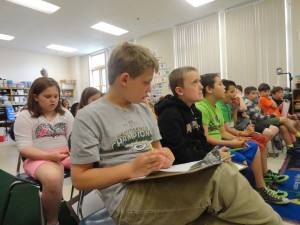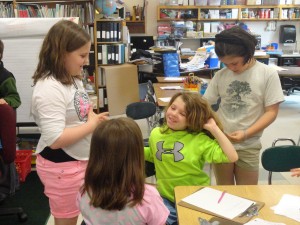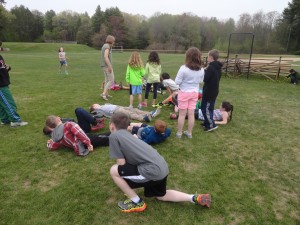 Another week – ZIP…ZING. I know we’ve been trying to use every second and still there is so much to accomplish. Every end of the year is the same. We’ll just keep working and doing our best to do as much as we can. Please be on the lookout next week for a student led conference sign up. These conferences will likely be held during the second week of June. The children will be sharing their digital portfolios and their selected work samples documenting learning progress of this year.
Another week – ZIP…ZING. I know we’ve been trying to use every second and still there is so much to accomplish. Every end of the year is the same. We’ll just keep working and doing our best to do as much as we can. Please be on the lookout next week for a student led conference sign up. These conferences will likely be held during the second week of June. The children will be sharing their digital portfolios and their selected work samples documenting learning progress of this year.
S.E.L. – Gratitude – Taking Time to Notice
This week we wondered about the expression: The most important things in life are not things. As we began to identify what we are grateful for, we explored books like We Are All Born Free, I Want to Be Free, and The Yellow Star- the legend of King Christian X of Denmark. It is challenging for the class to believe other human beings are treated with such little respect. The class was saddened and full of wonder at such cruelty. However, they could identify glimpses of this unkind side of human nature in the slights in the classroom and on the playground. They could see them in moments of cheating or hurtful things said, in over competitiveness or whispered secrets shared in front of others. I am proud of them for being aware of their actions and realizing how they can sting. They are trying to pay attention to their actions and the impact they have. We are trying to find balance between the needs of each individual and the collective needs of our whole class, our whole grade, moving on into the ever-widening community circles out into the world.
In considering what we need to feel content and successful we have begun to identify what we are grateful for in our lives. Each of us is working to identify an alphabet of gratitude. It is a challenge to take time to notice what is wonderful around us – hot and cold running water, heat and lights, sunshine, clouds… These conversations are bringing us full circle to our first weeks of school when we developed our classroom constitution. As I listen to the conversations and questions this week, it is clear that the children have become both more self- and socially aware this year. They are thinking of others and working to be responsible. They trying are taking care of themselves and considering others at the same time. We can be grateful for their efforts. They are caring people.
Habitats and Food Chains
 We had a habitat presentation this week done by the New Hampshire Department of Fish and Game. Through it we learned more about habitat requirements and of one we hadn’t considered before: SPACE. We knew about food, shelter and water, but space was a new idea, and suddenly, the reasons why different species become endangered made more sense.
We had a habitat presentation this week done by the New Hampshire Department of Fish and Game. Through it we learned more about habitat requirements and of one we hadn’t considered before: SPACE. We knew about food, shelter and water, but space was a new idea, and suddenly, the reasons why different species become endangered made more sense.
We could more easily understand how species that adapt to a variety of habitats have a greater chance of survival than those with a very specific space needs. We looked at the variety of large and small animals that might survive in the main types of NH habitat: field, wetlands and forest. We played a game called “Oh Deer” as a way to understand what naturally happens to animal populations when numbers grow while habitat remains constant. Ask your child about the plot graph created from the game as the deer population changed year to year.
 The final surprise was in learning what part of Earth provides habitat for us all. They used an apple for this. First the apple was cut into fourths. Of those four pieces, only one could possibly provide habitat. The rest is under water. That fourth was cut in half again. Now only one eighth of Earth was left. That is because about half of Earth’s surface is inhabitable when you combine desert and mountaintops, ice fields and other extremes. That eighth was cut again into three equal parts leaving one twenty-fourth as the piece of Earth remaining to provide the food all living things on earth require. The other parts are too full of people. And finally, of that twenty-fourth, only the top five feet or so can be used for food production – just the skin of the apple. It was striking. That example helped us understand the need for using resources wisely – to think about waste and reusing and reducing. These are all things we had heard of, but the examples helped us realize that every person’s actions DO make a difference. It was surprising to know that the Earth can be so big and so small at the same time.
The final surprise was in learning what part of Earth provides habitat for us all. They used an apple for this. First the apple was cut into fourths. Of those four pieces, only one could possibly provide habitat. The rest is under water. That fourth was cut in half again. Now only one eighth of Earth was left. That is because about half of Earth’s surface is inhabitable when you combine desert and mountaintops, ice fields and other extremes. That eighth was cut again into three equal parts leaving one twenty-fourth as the piece of Earth remaining to provide the food all living things on earth require. The other parts are too full of people. And finally, of that twenty-fourth, only the top five feet or so can be used for food production – just the skin of the apple. It was striking. That example helped us understand the need for using resources wisely – to think about waste and reusing and reducing. These are all things we had heard of, but the examples helped us realize that every person’s actions DO make a difference. It was surprising to know that the Earth can be so big and so small at the same time.
Bits and Pieces –
- We are continuing to work with division and fractions.

- We are further developing our research and informational writing skills through our State Wonders. We are gathering information and thinking about how we will present that information to you at The Parade of the States on May 28th.
- In read-aloud news, we finished The Secret of Zoom and began The Expeditioners and the Treasure of Drowned Man’s Canyon. Our new story is a complicated, fast moving adventure.
- Our broccoli continues to get bigger, taller and thicker. We are hoping for signs of a crop in a couple weeks. We can’t wait.
- We’ll be exploring the vernal pools during our outdoor challenge time next week.
